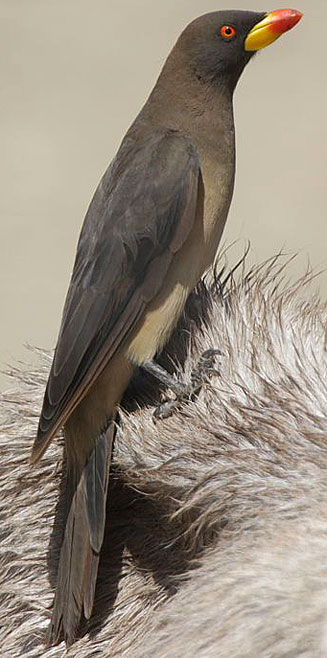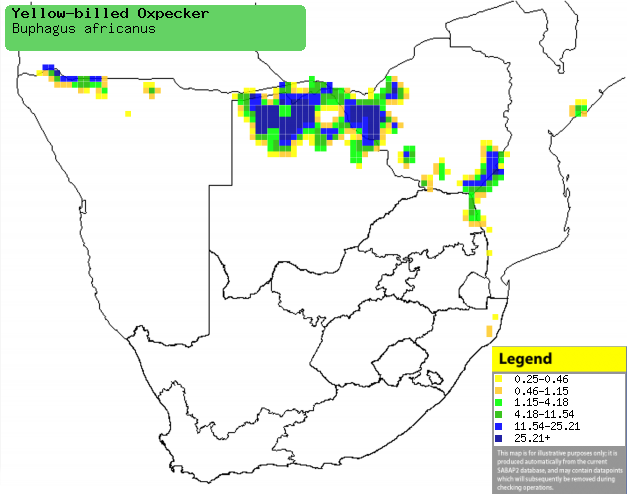|
Buphagus africanus (Yellow-billed oxpecker)
GeelbekrenostervoŽl [Afrikaans]; iHlalankomo,
iHlalanyathi (terms also applied to Red-billed oxpecker) [Zulu]; Kamugcara
(generic term for oxpecker; check: same name as Red-billed buffalo weaver and
African pygmy-goose) [Kwangali]; Tsande (generic name for oxpecker) [Shona];
Geelsnavel-ossepikker [Dutch]; Piqueboeuf ŗ bec jaune [French];
Gelbschnabel-madenhacker [German]; Pica-bois-de-bico-amarelo [Portuguese]
Life
> Eukaryotes >
Opisthokonta
> Metazoa (animals) >
Bilateria >
Deuterostomia > Chordata >
Craniata > Vertebrata (vertebrates) > Gnathostomata (jawed
vertebrates) > Teleostomi (teleost fish) > Osteichthyes (bony fish) > Class:
Sarcopterygii (lobe-finned
fish) > Stegocephalia (terrestrial
vertebrates) > Tetrapoda
(four-legged vertebrates) > Reptiliomorpha > Amniota >
Reptilia (reptiles) >
Romeriida > Diapsida > Archosauromorpha > Archosauria >
Dinosauria
(dinosaurs) > Saurischia > Theropoda (bipedal predatory dinosaurs) >
Coelurosauria > Maniraptora > Aves
(birds) > Order: Passeriformes
> Family: Sturnidae > Genus: Buphagus
 |
|
|
Yellow-billed oxpecker, Kunene River Lodge,
Namibia. [photo Trevor Hardaker ©] |
|
For information about oxpeckers, see
birdinfo.co.za.
Distribution and habitat
Occurs in patches across sub-Saharan Africa, from Senegal
to eastern Sudan south though Kenya and Tanzania, Zambia and Malawi to southern
Africa. Here it is locally common in the far north of Namibia, northern Botswana
and Zimbabwe, marginally extending into Mozambique and South Africa. It
generally prefers open savanna woodland, as it uses the large mammal inhabitants
as sources of ticks and other ectoparasites.
|
 |
|
Distribution of Yellow-billed oxpecker in southern Africa,
based on statistical smoothing of the records from first SA Bird Atlas
Project (©
Animal Demography unit, University of
Cape Town; smoothing by Birgit Erni and Francesca Little). Colours range
from dark blue (most common) through to yellow (least common).
See here for the latest distribution
from the SABAP2. |
Food
It mainly eats ectoparasites (such as ticks and lice) taken
from the skin of large mammals, especially Plains zebra (Equus
quagga), rhinoceros (both
African species), Hippopotamus (Hippopotamus
amphibius), Giraffe (Giraffa
camelopardis) and
bovines, specifically antelope, cattle and African buffalo (Syncerus
caffer). It may also glean blood and mucus from long hair, or drink
blood from wounds.
Breeding
- It typically nests in a tree cavity lined with grass and hair plucked from
its host mammals, although it may rarely use a hole in a wall.
- Egg-laying season is from September-March.
- It lays 2-3 eggs, which are incubated for about 13 days.
- The chicks leave the nest after about 25 days.
Threats
Not threatened globally but Vulnerable in South
Africa, where it is scarce and localised.
References
-
Hockey PAR, Dean WRJ and Ryan PG 2005. Roberts
- Birds of southern Africa, VIIth ed. The Trustees of the John Voelcker
Bird Book Fund, Cape Town.
|
